Design and Integration of a Retrofit PV–Battery System for Residential Energy Savings and Thermal Comfort †
Abstract
1. Introduction
2. Materials and Methods
3. Results and Discussion
4. Conclusions
- Cost-effectiveness and scaling: A detailed techno-economic analysis should be conducted so the model is scaled regarding incentives and electricity tariffs.
- Retrofitting in urban apartments: Broader implementation requires addressing practical installation issues in high-density buildings.
- User accessibility and smart interfacing: Future work can incorporate real-time monitoring dashboards empowering occupants to manage consumption with ease.
- Grid-assisted functionality and smart home integration.
Author Contributions
Funding
Institutional Review Board Statement
Informed Consent Statement
Data Availability Statement
Conflicts of Interest
References
- Energy Performance of Buildings Directive. Available online: https://energy.ec.europa.eu/topics/energy-efficiency/energy-performance-buildings/energy-performance-buildings-directive_en (accessed on 4 October 2025).
- Marques Lameirinhas, R.A.; Torres, J.P.N.; de Melo Cunha, J.P. A Photovoltaic Technology Review: History, Fundamentals and Applications. Energies 2022, 15, 1823. [Google Scholar] [CrossRef]
- Kosmadakis, I.E.; Elmasides, C.; Eleftheriou, D.; Tsagarakis, K.P. A Techno-Economic Analysis of a PV-Battery System in Greece. Energies 2019, 12, 1357. [Google Scholar] [CrossRef]
- Sun, Y.; Liu, D.; Flor, J.-F.; Shank, K.; Baig, H.; Wilson, R.; Liu, H.; Sundaram, S.; Mallick, T.K.; Wu, Y. Analysis of the Daylight Performance of Window Integrated Photovoltaics Systems. Renew. Energy 2020, 145, 153–163. [Google Scholar] [CrossRef]
- Li, Z.; Zhang, W.; Xie, L.; Wang, W.; Tian, H.; Chen, M.; Li, J. Life Cycle Assessment of Semi-Transparent Photovoltaic Window Applied on Building. J. Clean. Prod. 2021, 295, 126403. [Google Scholar] [CrossRef]
- Kim, S.; An, J.; Choi, H.; Hong, T. Assessment the Technical and Economic Performance of a Window-Integrated PV System Using Third-Generation PV Panels. Energy Build. 2023, 286, 112978. [Google Scholar] [CrossRef]
- Dallaev, R.; Pisarenko, T.; Papež, N.; Holcman, V. Overview of the Current State of Flexible Solar Panels and Photovoltaic Materials. Materials 2023, 16, 5839. [Google Scholar] [CrossRef] [PubMed]
- Ito, R.; Lee, S. Performance Enhancement of Photovoltaic Integrated Shading Devices with Flexible Solar Panel Using Multi-Objective Optimization. Appl. Energy 2024, 373, 123866. [Google Scholar] [CrossRef]
- Chaurasia, R.; Gairola, S.; Pal, Y. Technical, Economic Feasibility and Sensitivity Analysis of Solar Photovoltaic/Battery Energy Storage Off-grid Integrated Renewable Energy System. Energy Storage 2022, 4, e283. [Google Scholar] [CrossRef]
- Dufo-López, R.; Cortés-Arcos, T.; Artal-Sevil, J.S.; Bernal-Agustín, J.L. Comparison of Lead-Acid and Li-Ion Batteries Lifetime Prediction Models in Stand-Alone Photovoltaic Systems. Appl. Sci. 2021, 11, 1099. [Google Scholar] [CrossRef]
- Fassbender, E.; Rott, J.; Hemmerle, C. Impacts of Photovoltaic Façades on the Urban Thermal Microclimate and Outdoor Thermal Comfort: Simulation-Based Analysis. Buildings 2024, 14, 923. [Google Scholar] [CrossRef]
- Kumar, V.H.; Kishor, Y.; Patel, R.; Sahu, L.K. Efficiency Based Control Strategy for Off-Grid PV Integrated Battery Storage System. In Proceedings of the 2024 IEEE 11th Power India International Conference (PIICON), Jaipur, India, 10 December 2024; pp. 1–6. [Google Scholar]
- Rimpas, D.; Orfanos, V.A.; Chalkiadakis, P.; Christakis, I. Design and Development of a Low-Cost and Compact Real-Time Monitoring Tool for Battery Life Calculation. Eng. Proc. 2023, 58, 17. [Google Scholar] [CrossRef]
- Khalili, S.; Lopez, G.; Breyer, C. Role and Trends of Flexibility Options in 100% Renewable Energy System Analyses towards the Power-to-X Economy. Renew. Sustain. Energy Rev. 2025, 212, 115383. [Google Scholar] [CrossRef]
- PlusEnergy Flexible Solar Panel 100w Monocrystalline 12v Datasheet. Available online: https://www.wccsolar.net/en/flexible-solar-panel-100w-monocrystalline-12v/ (accessed on 2 October 2025).
- HY02B05 Wi-Fi Thermostat Manual. Available online: https://www.technolysis-hts.gr/wp-content/uploads/2018/03/HY02B05-wifi-thermostat-Manual.pdf (accessed on 2 October 2025).
- Xiaomi Mi Temperature and Humidity Monitor 2 Manual. Available online: https://manuals.plus/_mi/mi-temperature-and-humidity-monitor-2-lywsd03mmc-manual (accessed on 3 October 2025).
- BLUETTI AC50P Portable Power Station User Manual. Available online: https://cdn.shopify.com/s/files/1/0536/3390/8911/files/AC50P_User_Manual_US_EN-FR-ES.pdf?v=1745399644 (accessed on 4 October 2025).
- Zieba Falama, R.; Yaouba; Menga, F.-D.; Hamda Soulouknga, M.; Kwefeu Mbakop, F.; Ben Salah, C. A Case Study of an Optimal Detailed Analysis of a Standalone Photovoltaic/Battery System for Electricity Supply in Rural and Remote Areas. Int. Trans. Electr. Energy Syst. 2022, 2022, 7132589. [Google Scholar] [CrossRef]
- Christakis, I.; Orfanos, V.A.; Chalkiadakis, P.; Rimpas, D. Real-Time Monitoring of a Lithium-Ion Battery Module to Enhance Safe Operation and Lifespan. Eng. Proc. 2024, 82, 66. [Google Scholar] [CrossRef]
- Baghdadi, A.; Abuhussain, M. In-Depth Analysis of Photovoltaic-Integrated Shading Systems’ Performance in Residential Buildings: A Prospective of Numerical Techniques Toward Net-Zero Energy Buildings. Buildings 2025, 15, 222. [Google Scholar] [CrossRef]
- Greece-Electricity Prices: Medium Size Households—2025 Data 2026 Forecast 2010–2024 Historical. Available online: https://tradingeconomics.com/greece/electricity-prices-medium-size-households-eurostat-data.html (accessed on 8 October 2025).






| Category | Value | Comments |
|---|---|---|
| Energy Generation | 11 kWh | Total produced |
| 0.55 kWh–1.45 kWh | Daily | |
| 200 W | Peak PV power | |
| 410 kWh | Annual projected | |
| 10–720 W/m2 | Solar irradiation | |
| Thermal Comfort | 1–2 °C | Reduced indoor temperature |
| Energy Management | 75% SoC or 379 Wh | Maximum battery discharge |
| 95% | PV capacity factor | |
| 500 W | Maximum load | |
| 20 to 90% SoC range | Battery life prolonging | |
| Minimum solar power losses | PV overproduction limitation | |
| Battery SoH reduction | 0% | |
| Projected Savings | €90 | Annually |
| Total Purchase Cost | €300 | Components and cables |
| Usability and Practicality | Ready to use system | Ease and safe installation |
| Gains | Cost-effective, robust, user-friendly |
Disclaimer/Publisher’s Note: The statements, opinions and data contained in all publications are solely those of the individual author(s) and contributor(s) and not of MDPI and/or the editor(s). MDPI and/or the editor(s) disclaim responsibility for any injury to people or property resulting from any ideas, methods, instructions or products referred to in the content. |
© 2025 by the authors. Licensee MDPI, Basel, Switzerland. This article is an open access article distributed under the terms and conditions of the Creative Commons Attribution (CC BY) license (https://creativecommons.org/licenses/by/4.0/).
Share and Cite
Rimpas, D.; Rimpas, N.; Orfanos, V.A.; Christakis, I. Design and Integration of a Retrofit PV–Battery System for Residential Energy Savings and Thermal Comfort. Eng. Proc. 2025, 117, 3. https://doi.org/10.3390/engproc2025117003
Rimpas D, Rimpas N, Orfanos VA, Christakis I. Design and Integration of a Retrofit PV–Battery System for Residential Energy Savings and Thermal Comfort. Engineering Proceedings. 2025; 117(1):3. https://doi.org/10.3390/engproc2025117003
Chicago/Turabian StyleRimpas, Dimitrios, Nikolaos Rimpas, Vasilios A. Orfanos, and Ioannis Christakis. 2025. "Design and Integration of a Retrofit PV–Battery System for Residential Energy Savings and Thermal Comfort" Engineering Proceedings 117, no. 1: 3. https://doi.org/10.3390/engproc2025117003
APA StyleRimpas, D., Rimpas, N., Orfanos, V. A., & Christakis, I. (2025). Design and Integration of a Retrofit PV–Battery System for Residential Energy Savings and Thermal Comfort. Engineering Proceedings, 117(1), 3. https://doi.org/10.3390/engproc2025117003






